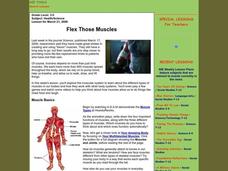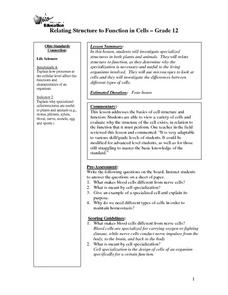Curated OER
Can You Make a Muscle?
Why are muscles important? Third graders study the different kinds and functions of muscles in the human body. After drawing arrows in an illustration to indicate where a muscle contraction would occur, they do their own experiment about...
Curated OER
Animal Structure and Function
Take a look at the levels of organization and methods of homeostasis in living things. This worksheet requires biology enthusiasts to list categories of animal tissues, connective tissues, and muscle tissues. It has them order the levels...
Curated OER
Past Continuous vs. Simple Past
What were you doing a minute ago? What about last year? Learners read a set of 10 sentences and fill in each blank with a simple past or past continuous verb listed in parentheses.
Curated OER
Exploring Muscle Action in the Human Body
Students collect and graph data and use the internet to research the skeletal muscles.
Curated OER
Cardiac Function
In this health worksheet, young scholars look for the connections needed to attain the knowledge of cardiac function. The sheet includes the background information.
Curated OER
Why Muscle Biology?
Young scholars research and define a muscle biology research question and organize an experiment to address the question utilizing either NADH staining or acid buffering. They analyze data as well as draw conclusions about their...
University of Minnesota
Virtual Neurons
It's electric! Young anatomists use Virtual Neurons software to build, control, and analyze complex nerve circuits within the body. Colorful and packed with content, class members enjoy interacting with the nervous system at a personal...
Curated OER
Sensory and Motor Mechanisms
Advanced biology pupils name the function of each individual structure on figures of the eye and the ear. They describe the purpose of the skeleton and how it works with the muscles to create movement. Finally, they label a large diagram...
Gustavus Adolphus University
Five Physical Fitness Components
Five learning stations for five physical fitness components: cardiovascular exercise, body composition, muscle endurance, muscular strength, and flexibility. As pupils progress through each station, they will complete assigned tasks,...
Curated OER
MuscleMania
Students learn three different types of muscles. By building a model of the arm, they learn its basic anatomy and how muscles function in relationship to bones. They perform an experiment on the relationship between muscle size and...
Rochester Institute of Technology
Biomechanical Joint
Discuss mechanical advantage and how the human body moves/works. Learners focus on bioengineering, working together to build a functioning mechanical arm. Additionally, they analyze an air muscle, discussing its appropriate use in humans.
Curated OER
The Animal Body and How it Moves
Spark interest in the body structure of vertebrates with this comprehensive and colorful worksheet. Your biology class will explore the levels of organization, primary tissue types, and the main organ systems. Finally, they hone in on...
Curated OER
Tissues
Complete with teachers' notes for most of the slides, this is a tremendous presentation of the four types of tissues: epithelial, connective, nerve, and muscle. Each is displayed with pertinent vocabulary and photos of microscope slides...
Smarter Balanced
How the Brain Works
Cerebrum, cerebellum, brainstem, pituitary gland, and spinal cord. Prepare your class for a performance task assessment on the brain and how it works with a scripted plan that defines these terms and identifies the functions the parts...
Curated OER
Flex Those Muscles
Students explore the muscular system to examine the different types of muscles in our bodies and how they work with other body systems. They discover how muscles help us chew food and laugh. Videos are used as part of this lesson.
Curated OER
Sing Along with the Muscles Song
Students review the muscles of the body. They perform the functions of the muscles of the body to the tune of "Rudolph the Red Nosed Reindeer".
Curated OER
Enhancing Uptake of Glucose in Rabbit Muscle Cells
Students observe diffusion of glucose through a cell membrane and research the function of chromium picolinate in glucose uptake into a cell. They conclude and understand the role of insulin and chromium picolinate in the uptake of...
Curated OER
Muscle Movements
Students participate in a game to identify major muscle groups in the body and gain an understanding of muscle functions.
Curated OER
Integrating Biology-Muscles and Work
In this muscle and work learning exercise, students read about aerobic, anaerobic and resistance exercise. They apply what they read and answer three questions about these three types of exercise.
Curated OER
Structure and Function
Structure and Function
SynopsisStudents choose some biological object, examine its structure, and identify or speculate on one particular function. Next they create a blueprint of the object, focusing on the particular function. Then...
Curated OER
Relating Structure to Function in Cells
Twelfth graders investigate specialized structures in both plants and animals. They relate structure to function, as they determine why the specialization is necessary and useful to the living organisms involved. They use microscopes...
Illustrative Mathematics
Logistic Growth Model, Abstract Version
Here learners get to flex some serious algebraic muscles through an investigation of logistic growth. The properties of the constant terms in the logistic growth formula are unraveled in a short but content-dense activity. Moving...
Intel
Cell-to-Cell
The third in a series of 10 STEM project-based lessons focuses on cells types, functions, and physiology. Through research, discussions, writings, and presentations, groups learn about the difference between plant and animal cells, the...
Southwest Educational Development Laboratory
The Human Body
Nothing is more relevant than the study of the human body. A series of 10 human body lessons begins with growth, ends with reproduction, and hits all the major systems in between. Each lesson provides opening and closing activities as...

























